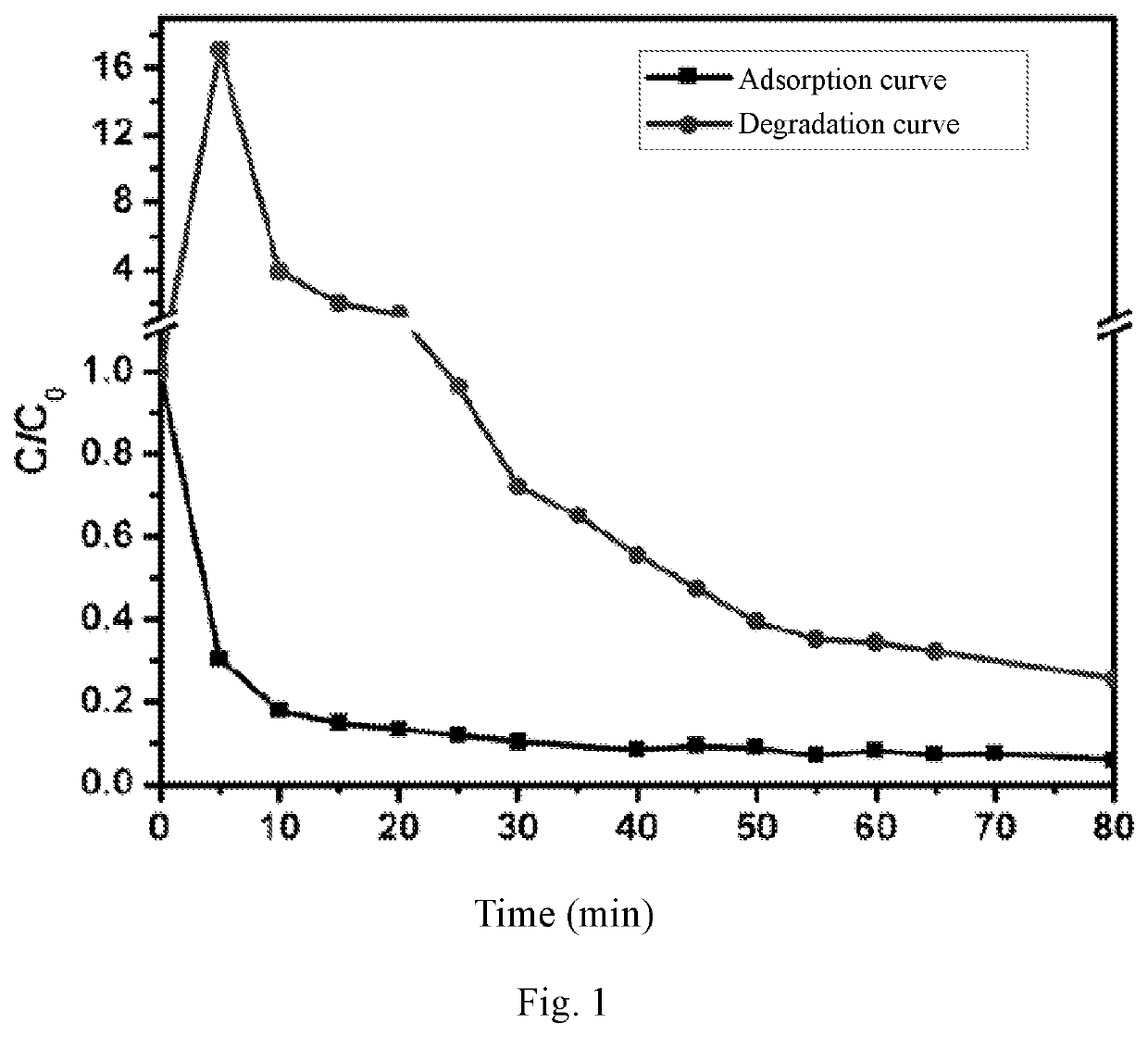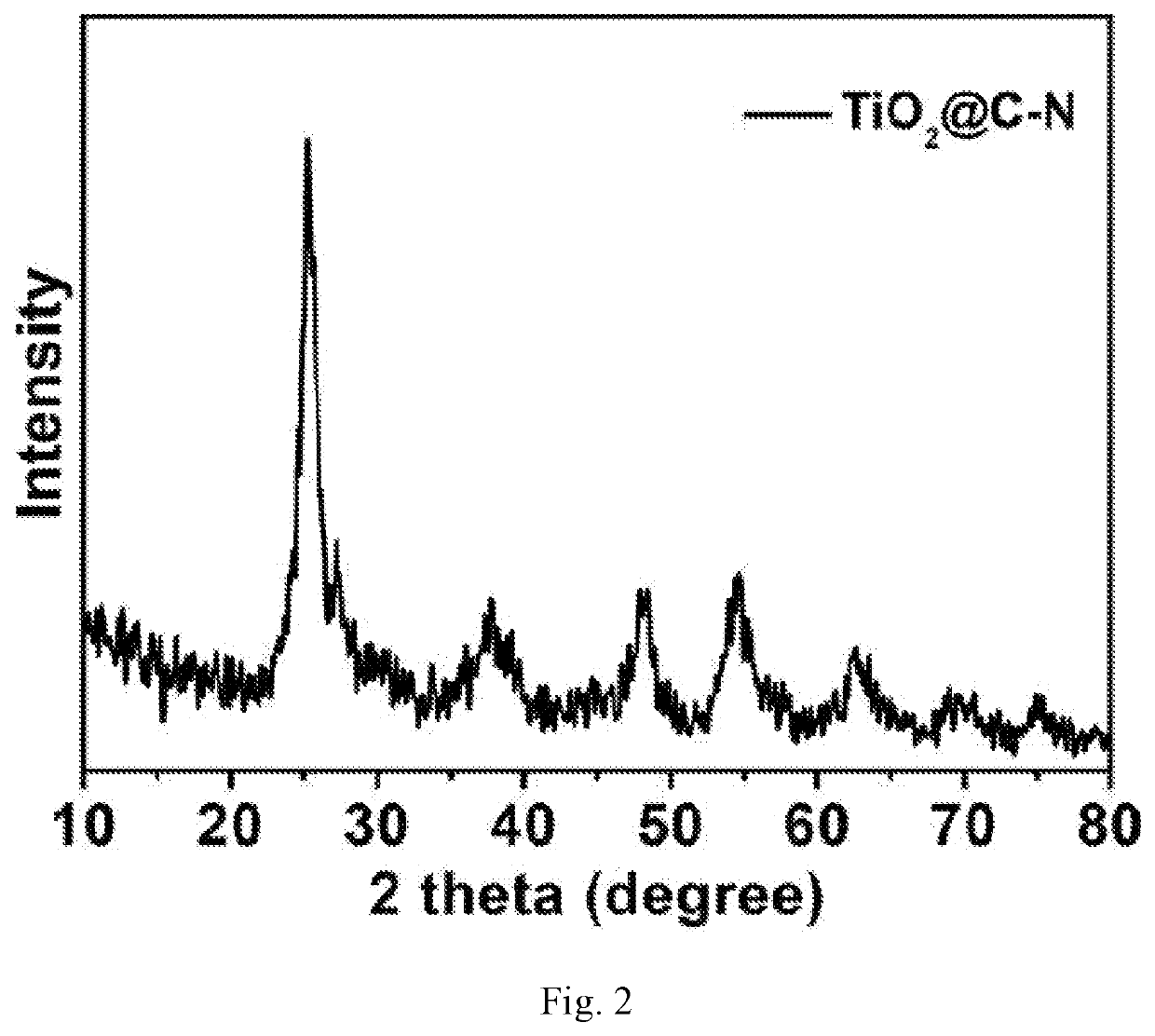A Nitrogen-Doped Mesoporous Carbon-Coated Titanium Dioxide Composite Photocatalyst, a Preparation Method and Use Thereof
a carbon-coated titanium dioxide and composite photocatalyst technology, applied in the field of adsorption type photocatalysts, can solve the problems of limiting the application of environmental purification, affecting human health and ecological environment, and effectively using, so as to improve the catalytic activity and stability of the composite photocatalyst, increase the specific surface area of tio2, and reduce the utilization rate of sunligh
- Summary
- Abstract
- Description
- Claims
- Application Information
AI Technical Summary
Benefits of technology
Problems solved by technology
Method used
Image
Examples
example 1
[0031]1. Preparation of Photocatalytic Material
[0032]S1. Mix 2-aminoterephthalic acid, Ti(OC3H7)4, methanol and DMF at a molar ratio of 3:2:23:118 and add them to a reaction vessel with polytetrafluoroethylene;
[0033]S2. Place the reactor in an oven, set the program, raise the temperature to 150° C. at a rate of 1° C. / min, then maintain the temperature for 48 h, finally cool down at a rate of 5° C. / h down to room temperature to obtain a precipitate;
[0034]S3. Cross wash the precipitate obtained in S2 with methanol and DMF, conduct centrifugation and vacuum drying at 150° C. for 12 h to obtain an activated Titanium-based MOF material;
[0035]S4. Place the activated Titanium-based MOF material prepared in S3 in a tube furnace, raise the temperature from room temperature to 600° C. at a rate of 1° C. / min under Ar atmosphere, and maintain this temperature for 6 h; then, lower the temperature to 500° C. at a rate of 1° C. / min and keep it for 30 min, during which Ar is replaced with CO2; fina...
example 2
[0038]S1. Mix 2-aminoterephthalic acid, Ti(OC3H7)4, methanol and DMF at a molar ratio of 3:2:23:118 and add them to a reaction vessel with polytetrafluoroethylene;
[0039]S2. Place the reactor in an oven, set the program, raise the temperature to 150° C. at a rate of 5° C. / min, then maintain the temperature for 72 h, finally cool down at a rate of 5° C. / h down to room temperature to obtain a precipitate;
[0040]S3. Cross wash the precipitate obtained in S2 with methanol and DMF, conduct centrifugation and vacuum drying at 120° C. for 24 h to obtain an activated Titanium-based MOF material;
[0041]S4. Place the activated Titanium-based MOF material prepared in S3 in a tube furnace, raise the temperature from room temperature to 700° C. at a rate of 2° C. / min under Ar atmosphere, and maintain this temperature for 7 h; then, lower the temperature to room temperature at a rate of 2° C. / min to obtain a nitrogen-doped mesoporous carbon-coated TiO2 composite photocatalyst.
example 3
[0042]S1. Mix 2-aminoterephthalic acid, Ti(OC3H7)4, methanol and DMF at a molar ratio of 3:2:23:118 and add them to a reaction vessel with polytetrafluoroethylene;
[0043]S2. Place the reactor in an oven, set the program, raise the temperature to 150° C. at a rate of 1° C. / min, then maintain the temperature for 48 h, finally cool down at a rate of 5° C. / h down to room temperature to obtain a precipitate;
[0044]S3. Cross wash the precipitate obtained in S2 with methanol and DMF, conduct centrifugation and vacuum drying at 150° C. for 8 h to obtain an activated Titanium-based MOF material;
[0045]S4. Place the activated Titanium-based MOF material prepared in S3 in a tube furnace, raise the temperature from room temperature to 500° C. at a rate of 3° C. / min under Ar atmosphere, and maintain this temperature for 9 h; then, lower the temperature to 300° C. at a rate of 3° C. / min and keep it for 60 min, during which Ar is replaced with CO2; finally, adjust the atmosphere back to Ar atmosphere...
PUM
| Property | Measurement | Unit |
|---|---|---|
| temperature | aaaaa | aaaaa |
| temperature | aaaaa | aaaaa |
| temperature | aaaaa | aaaaa |
Abstract
Description
Claims
Application Information
 Login to View More
Login to View More - R&D
- Intellectual Property
- Life Sciences
- Materials
- Tech Scout
- Unparalleled Data Quality
- Higher Quality Content
- 60% Fewer Hallucinations
Browse by: Latest US Patents, China's latest patents, Technical Efficacy Thesaurus, Application Domain, Technology Topic, Popular Technical Reports.
© 2025 PatSnap. All rights reserved.Legal|Privacy policy|Modern Slavery Act Transparency Statement|Sitemap|About US| Contact US: help@patsnap.com


